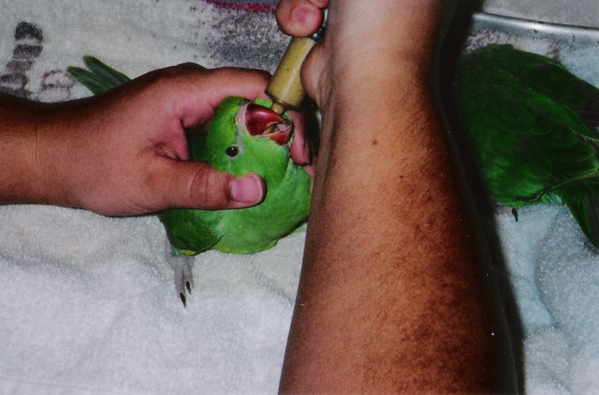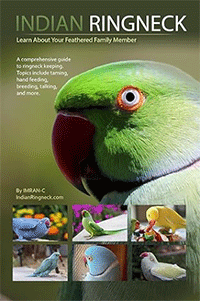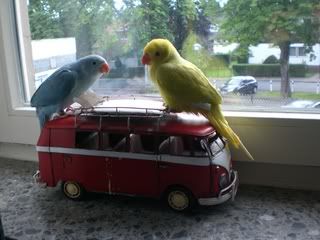Hand Feeding
Your best bet it to go ask a breeder and have him/her show you in person how they handfeed. Please get someone experienced to show you before trying yourself!
Have a handfeeding "kit" and keep everything together. I used an old cookie sheet. I put paper towels on the bottom since I left everything to dry on it after each feeding.
My kit:
syringe
spoons (one for scooping formula and one for mixing it with the water)
mixing cup (mine was a plastic cup for lunches, lol)
pyrex or other microwave safe container for heating the water
digital thermometer, we ended up with one for meat, candy ones work great
a roll of paper towels (you'll never have enough!)
Exact formula was kept in the fridge
I handfed in our kitchen. The microwave is right there, sink for washing, and it was open space. The babies were in my room upstairs so we just brought them down for their feedings. We would set them in a turkey baking pan since the high sides wouldn't let them roll/scoot off the table. Just an old towel in the pan for them to sit on. They don't like sliding around on metal or wood while they're eating.
I did about three test runs in the kitchen before we ever got our babies to find out: 1) How long was needed to microwave the water to reach proper temp. and keep it's temperature when the formula (which was refrigerated) was added. 2) The ratio of water to formula. And 3) How to do everything smoothly.
We used a two cup pyrex liquid measure for heating our water (use natural spring water, NOT distilled). The container for mixing the formula in was marked as to how much water was needed for the formula. Because you're not mixing the formula in the container you heated water in, you don't need to worry about "hotspots". Believe me, you'll be mixing it so much the temperature evens out perfectly.
Once the formula is the consistency you want (at first it will be like loose grits, then thickens as the chick ages; by the time they were weaning, it was just barely thin enough to move through the syringe easily), add the thermometer and get it down (stirring) to 107 degrees F. I prefer to feed between 104 and 107. You *can* go to 103 but I wouldn't- since the formula already cools when in the syringe. If the temp falls below 104, just place the container with the formula into the still hot water (the hot water from the microwave, this is another reason we use separate containers) until it gets back up to temp. If it doesn't get hot enough, heat the water container for a bit and try again. It can be a juggling act but when you are faster at feeding you won't usually have this problem. Mikaela is 100% correct when she stated: "never nuke the formula" itself. (nuke= microwave)
This is where a schedule comes in that you can modify. Try to only feed when the crop is empty, that way you don't have old food sitting around in it with the new. If your chick's crop is moving slowly (gauge from the other birds) add a little baby food (green vegetable) to your formula. That will help move things along. Try a thinner mix too and keep an eye on the crop. Adjust feeding schedule if needed.
While you are feeding, you will see the crop begin to bulge. His crop is at the base of his neck. Like a balloon. Do not overfeed. Most chicks will refuse food when the crop is full, but others will continue to eat. Once you have an idea of what the crop should look like, you will have no problem making sure they eat enough.
It is easier to feed one baby at a time, since once you get them to take a little they eagerly eat more. This will allow you to gauge crops better as well and keep track of who has already eaten. A baby barely crawling around because of his belly with his eyes glazed over in happiness has obviously already eaten.
My schedule (days are the chick's age in days):
18- 27 days 6:00am, 10:00am, 2:00pm, 6:00pm, 10:00pm
28- 35 days 6:00am, 11:30am, 5:00pm, 10:30 pm
36- 42 days 6:00am, 2:00pm, 10:00pm
42- weaned 10:00pm
I allowed myself a half-hour give in times once they got to three feedings; remember it takes about ten or fifteen minutes from heating the water to beginning feeding so include that in your estimate. And let the baby birds set the pace.
When I first got the babies (at three and a half weeks old) I started with the 18-27 day regimen, since they were used to getting fed often from the parents. After about five days we moved to the 28-35 day and dropped feedings from there.
This is just a guideline, what worked for our birds might not be exactly what yours need. And the times can be shifted depending on your schedule, just try to keep the same time-span between feedings.
They'll begin refusing food around fledging time but make sure they eat enough. They're not weaning, just dieting to get weight down for flying. Little buggers try to trick us.
I didn't originally want to put ammounts here, since I really think you SHOULD go learn from a breeder how to feed. But not everyone will go do that. So to help prevent disaster, here is what Donna said:
Donna wrote:Age of Chick Feeding Times/Feeding Amounts
1-4 days Every two hours 1 - 2 cc's
5-7 days Every three hours 2 - 3 cc's
8-14 days 7:00 AM, 11:00 AM, 3:00 PM, 7:00 PM, 11:00 PM 4 - 6 cc's
15-24 days 7:00 AM, 12:00 PM (Noon), 5:00 PM, 11:00 PM 7 - 10 cc's
25-34 days 7:00 AM, 5:00 PM, 11:00 PM 11 - 15 cc's
35-44 days (fledging) 7:00 AM, 7:00 PM 11 - 15 cc's
45 days to weaning 7:00 PM 11 - 15 cc's
The crop should be firm and round not bulging. After babies are 1 week old I don't feed through the night so the crop has time to empty completely in 24 hours.
This was little Hane when I was handfeeding him, he always insisted on eating first so Tsume had to wait.
This is what Mikaela was talking about, feeding towards the right side of the bird, from it's left.

You can also try cup feeding, which seems the easiest. http://www.parrotpro.com/cupfeed.php
- Tips:
- The temperature of the formula will depend on the brand you use. Check the directions on your formula.
- I don't reccomend gavage or tube feeding. A syringe is less risky. Cup feeding is even less risky.
- If the syringe gets a little sticky just put some sunflower seed oil around the edge of the rubber before assembling for feeding. Then it will glide smoothly.
- Until they begin to feather out, keep the chicks out of cold areas and cover them to stay warm. Have a heating pad under or heating lamp over only half the enclosure so they can get away from the heat if they become too hot. If they are all huddled together on the heating pad or under the heating lamp, they are too cold.
- Spend time with the chicks after they have been fed. Scratch their little heads and talk to them. Tell them how ugly they are and how beautiful they'll be when they feather out. And touch their feet.
- ALWAYS clean everything with hot water and soap after each feeding. Try to clean immediately, crusted on formula is no fun.
- If you get any formula on the chick, use a paper towel dipped in warm water to wipe it off.
- Clean the cage or tank before placing the chicks back in- sanitation is important.
- Use a small cage to prevent injuries if they fall while learning to climb bars and keep perches low at first. Until they can perch or walk around, don't use the metal grate bottom if you're using a cage.
- Let them learn how to fly. I feel it's important to a bird's mental health to fledge properly. Once they can land without crashing, then you can clip if you choose. Learning to fly also helps them learn how to glide down after clipping and helps prevent injuries.
Dangers for handfeeding if not properly trained
Aspiration- Forcing formula into the babies mouth to fast or improperly causing the baby to aspirate the formula
Burnt Crops- Using formula that is not at the proper temp.
Stretched Crops- Forcing the baby to take more formula then he can handle stretching the crop to the point that it can not empty properly (in very young chicks)
Bacterial Infections- Can be caused by not cleaning the nursery or equipment used for hand feeding. Can also be caused by contaminated food.
Malformed Beaks- Babies beaks are still soft and pressing the syringes into their beaks can create malformation in the beak.
Dehydration- If you do not mix the formula properly you could be given them the wrong consistency.
Poor Weight Gain- Formula too thin, Not following correct feeding schedule, Not feeding enough
Parts 1 & 2 of an excellent hand-feeding article:
http://www.birdsnways.com/wisdom/ww8eiii.htm
http://www.birdsnways.com/wisdom/ww7eii.htm
Weaning
We are fortunate that IRNs are such great eaters and this has made weaning for us very easy. We chose to abundance wean our birds so they would be exposed to all sorts of flavours and would be accustomed to trying new things.
When our birds first began to refuse full feedings (meaning would eat most but not as much as they did before), we diced up soft veggies and held a piece one at a time between our fingers and deposited it into the chick's waiting mouth. Similar to how a parent bird would feed a chick. Usually at first they would indiscriminately swallow anything in their mouth, then later would pause and manipulate it in their beak before swallowing. We would feed them veggies while the formula was heating up.
Once they began to manipulate the food, we kept a shallow, light coloured dish with finely diced veggies or warm mash in the cage along with a sprig of millet. At first they only play with the foods but eventually will begin eating more of it. We kept millet always available and switched the types of veggies and fruits daily.
Once the chicks began cracking and actually eating the millet seeds, we added another dish with small pellets. The key is to offer everything and expose the chick to as many foods as possible.
We kept up all feedings until the chicks decided they didn't need a particular one anymore and after a few days of them not eating or hardly eating any formula at that time, that feeding was dropped. One at a time the feedings were dropped as the chicks refused, keeping only the last one at night- a chick should go to sleep on a full crop.
We monitored the intake of each chick, checking crops throughout the day to be sure they were eating well. The final feeding was dropped only when they all refused the formula and had adequately full crops from feeding themselves.
Hane and Tsume's first solid food was squash. The first food they ate eagerly and really started them on solid foods was cucumber- ooooh the gooey seed part!
Sometimes we would warm the veggies to make them softer and because they were accustomed to warm formula (I chose to begin only with veggies since most parrots unused to them seem to turn up their beaks at the "healthy" foods and want sweet fruits- just like kids!).
Sweet Potato Mash was the easiest tool for getting them to try new foods. It is warm and mushy- precisely what a young chick loves!
Rough chop a sweet potato and boil until fork tender, drain and mash. Finely dice a whole bunch of different veggies (can add frozen ones too like peas) and mix it into the mashed potato. Freeze in ice cube trays for handy serving sizes. Heat up and serve!
Shallow, light coloured dishes seemed to be the easiest for our chicks to eat from.
Veggies/Fruits List: viewtopic.php?f=3&t=8078
Here is a good article explaining why abundance weaning is the best method and questions to ask your breeder to make sure your chick has been weaned properly!
http://www.birdsnways.com/wisdom/ww4e.htm
And another article found by subodh, explaining the Why and How of the Weaning Process http://theparrotuniversity.com/arthandfeeding3.php









